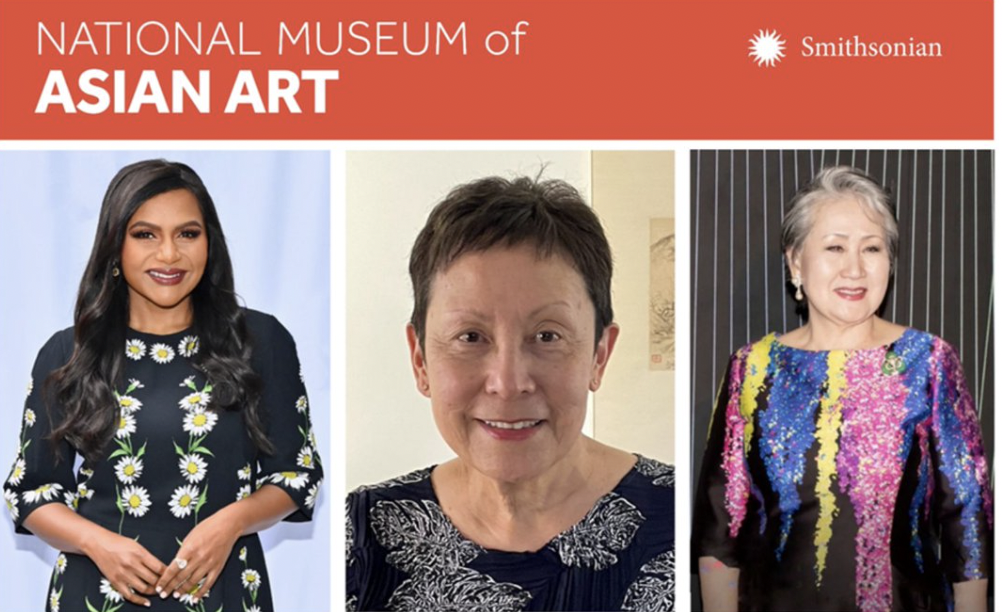★★★★☆
The Smithsonian’s National Museum of Asian Art turns the everyday into exhibitions that dazzle in its 2023 selection of curated masterworks. Objects from bowls to Buddhas line the gallery walls, culminating in an immersive and eye-opening display that is undeniably worth the trip.
“The Peacock Room,” an elegant masterpiece of interior design, is particularly arresting. Its title is far from a misnomer; wealthy businessman Frederick Leyland financed the redecoration of his London dining room, in which he found the perfect opportunity to showcase his expansive collection of blue and white Chinese porcelain. When art collector Charles Lang Freer purchased the room and reassembled it in Detroit, Mich., he added his own stockpile of ceramics, with origins ranging from Syria to Korea.
“The Peacock Room” found its final home in the Freer Gallery of the Museum of Asian Art. The ceiling-high turquoise walls are adorned with golden patterns and peacock illustrations, perfectly complementing the more neutral tones of the shelved ceramics.
Jump 5,000 years back and such animal patterns are still pervasive. Elaborate jade carvings would take the form of dragons and various felines and were almost always circular in nature. Though the museum did not make the creatures’ exact meanings explicit, the accompanying placards sufficiently explained the funerary nature of the jade. The pieces were buried with their owners and serve as a time capsule into Neolithic and early Bronze era China, the earliest periods of its history.
The “Tibetan Buddhist Shrine Room” is similarly spiritual. Filled with over 200 sculptures and tapestries, the room is reminiscent of a portal between the sacred and earthly worlds. An auditory element accompanies the display of Himalayan art. The rhythmic, eerie humming of monks is meant to evoke emotion from viewers to more closely tie them to the objects on view.
A second array of sculptures can be found in the “Promise of Paradise” exhibit. These artworks are Chinese in origin and vary greatly in size. From household altars to smaller pieces of colossal cave sites, the buddhas and bodhisattvas guide onlookers through their spiritual journey, whether that be a mere walkthrough of the gallery or a deeper religious revelation.
Just a few hundred miles east during the same epoch, ceramics began to blossom in Korea. The Goryeo period (918–1392) marked the spread of the celadon style, characterized by a translucent, gray-green glaze. Over time, however, celadon fell out of favor with the elite and homes and places of worship replaced it.
When many of these wealthy figures’ tombs were looted in the early 1800s, the ceramics they were buried with were sold as “antiques.” American Horace Newton Allen took advantage and formed his own collection. It was then purchased by Charles Lang Freer in 1907, whose large acquisition sparked a new passion for rediscovering caledon within the artistic community at large. Pieces from vases to bowls to utensils can thus be found in the National Museum.
Art also takes the form of practical objects in the “China and the Silk Road” exhibition. Luxurious dining-ware was pervasive in northwest China at sites like Chang’an — modern day Xi’an — due to its proximity to the Silk Road. Trade routes connected the city with merchants from across the continent. Most impactful of all were travelers from the kingdom of Sogdiana. These traders spoke Persian and would have lived in the western regions of Uzbekistan and Tajikistan, bridging Chinese and Iranian cultures.
“China and the Silk Road” is a visual representation of this connection. Objects from a box in the shape of a melon to elaborate, floral mirrors made of gold are Chinese in origin but showcase the Sogdians’ lavishness.
Even the stories of these metals are highlighted down to every detail. The importance of gold throughout history, for example, begins with the first mine in Egypt circa 1320 BCE. The English word “gold,” viewers learn, derives from the Sanskrit term for “shining.” Upon its introduction to the New World, gold began to take the form of currency. But its role transcends economics. Rather, gold’s chemical composition renders it malleable yet sturdy enough to be sought after for artistic purposes worldwide.
Holistically, the National Museum of Asian Art does an excellent job of underscoring this international facet of the pieces it displays. It is admittedly alarming that most of the galleries were donated by Charles Freer, a white American with no ties to the East Asian region. Despite the exhibits’ origins, however, they provide an in-depth view into Asian art history. Across both countries and centuries, the exhibitions on view at the National Museum are scintillating.














